|
 Clavulina brunneocinerea Clavulina brunneocinerea
BiostatusPresent in region - Indigenous. Endemic
Images (click to enlarge)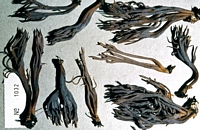
Caption: 1032, id. R. Petersen, label 50x10mm, NZ, NI, Auckland, Waitakere R., Huia, Karamatura Stream, on soil in broadleaf-conifer forest, 01.07.1981, leg. EH
Owner: E. Horak | 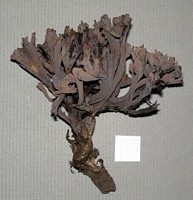
Owner: J.A. Cooper | 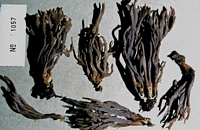
Caption: 1057, id. R. Petersen, label 50x10mm, NZ, NI, Waitakere R., Mill Bay, on soil among litter under
Leptospermum-Phyllocladus-Dacrydium, 06.07.1981, leg. EH
Owner: E. Horak | 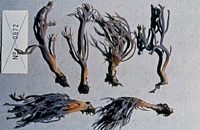
Caption: 1516, id. R. Petersen, label 50x10mm,
Owner: E. Horak | 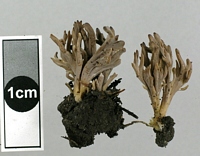
Owner: J.A. Cooper | 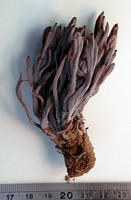
Caption: fruitbody
Owner: J.A. Cooper | 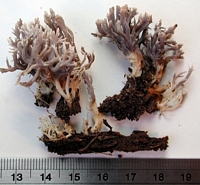
Caption: fruitbody
Owner: J.A. Cooper | 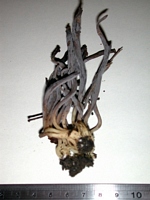
Owner: J.A. Cooper | 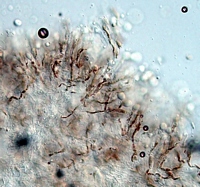
Caption: brown granules/oily thin hyphae in KOH
Owner: J.A. Cooper | 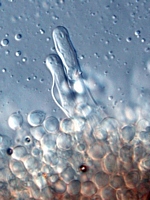
Caption: emergent cystidia in KOH
Owner: J.A. Cooper | 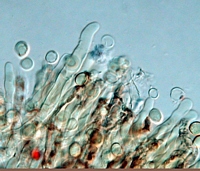
Caption: emergent cystidia in Melzer's
Owner: J.A. Cooper | 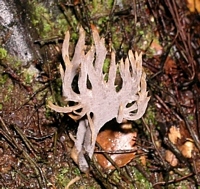
Caption: FUNNZ photo
Owner: J.A. Cooper | 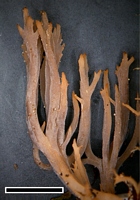
Caption: FUNNZ photo. Scale=5mm
Owner: J.A. Cooper | 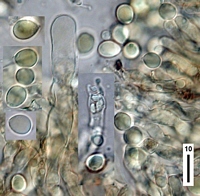
Owner: J.A. Cooper | 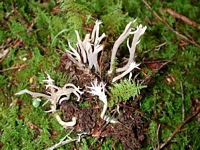
Caption: fruitbody
Owner: J.A. Cooper | 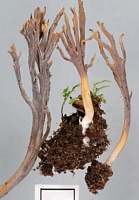
Owner: J.A. Cooper | |
Article: Petersen, R.H. (1988). The clavarioid fungi of New Zealand. New Zealand Department of Scientific and Industrial Research, Bulletin 236: 170 pp. Wellington:.
Description: Fruit bodies up to 9 cm high, up to 4 cm broad, repeatedly branched, more or less arbuscular. Stipe 0.5-4 cm x 3-7 mm, distinct, irregular in cross section, not terete, whitish below ("cream buff"), and there matted to tomentose, tan to brownishtan ("clay-color") above and into lower branches and sterile areas; flesh stuffed to lightly stuffed to hollow. Major branches 2-several, channelled to flattened, rebranching 1-4 times; axils rounded to narrowly rounded, internodes diminishing irregularly and gradually. Branches mouse-grey to quaker-grey ("drab", "wood-color", "hair-brown") on hymenial surface; hymenium clearly unilateral, with sterile areas predominant on lower branches but hymenium amphigenous on upper branches; hymenium minutely papillose from clusters of cystidia at x60. Apices moderately long to long, acute to acerose, not dichotomous, pale dull violaceous ("drab"); Odour and taste negligible.
Tramal hyphae of branches up to 12 gm dram., hyaline, free, more or less parallel, thin- to slightly thick-walled (wall up to 0.5 gm thick), clamped. Subhymenium poorly developed, of inflated, short cells. Hymenium thickening significantly; basidia (Fig. 45) 65-75 x 7-8 gym, cylindrical, clamped, hyaline when young, and often appearing as non-emergent cystidia; contents multiguttulate when mature, the guttules highly refringent; sterigmata 2, stout, curved-divergent; post-partal septation present or absent. Cystidia (Fig. 46) occasional to rare, often in groups or clusters, 110-150 x 10-12 gm, cylindrical, aseptate, slightly thick-walled (wall up to 1 gin thick), hyaline below, refringent for apical 20-30 pm, clamped, emergent up to 40 gym, visible at x60.
Spores (Fig. 47) 7.9-9.4 x 6.5-8.3 R in (E =1.05-1.33; E¬1.17; Lm = 8.49 gm), subglobose to very broadly ovate, thin-walled, opalescent to uniguttulate; hilar appendix small, papillate.
Habitat: On soil or humus under forests.
Notes: The species is well marked by: (i) the brown and grey colouration of mature fruit bodies, (ii) the occasional cystidia; and (iii) the unilateral hymenium of at least the lower branches. If one attempts to use Corner's (1970) key to cystidiate Clavulina taxa for C. brunneo-cinerea, one is led to C. mussooriensis, which Corner reports from New Zealand. Although I have not seen the New Zealand material to which he referred, there is some indication that mixed material was examined. That C. brunneocinerea was part of that material can be inferred by the citation of colours, branched fruit bodies, and cystidia. Concomitantly, Corner also cited simple fruit bodies and the presence of post-partal septation, both characteristic of C. geoglossoides and neither characteristic of C. brunneo-cinerea. As in Clavulina geoglossoides, cystidia occur in clusters, but so far as I can tell; they are much less common in C. brunneo-cinerea. Occasionally, the cystidia branch laterally in the middle, from a clamped septum, and both the original cystidium and the branch develop into the characteristically refringent cystidial tips. In large or luxuriant fruit bodies, the lower stem is covered with a white, strigose-felty tomentum which may extend on to the substrate as a mycelial mat. This may obscure the tan colour of the stem, but I have not seen a collection in which no fruit bodies showed the light brown base.
Post-partal basidial septation is rare or absent in most collections, but locally common or universally so in some (notably TENN no. 43424). This coincides with observations on other taxa, rendering the character suspect at the species rank.
|